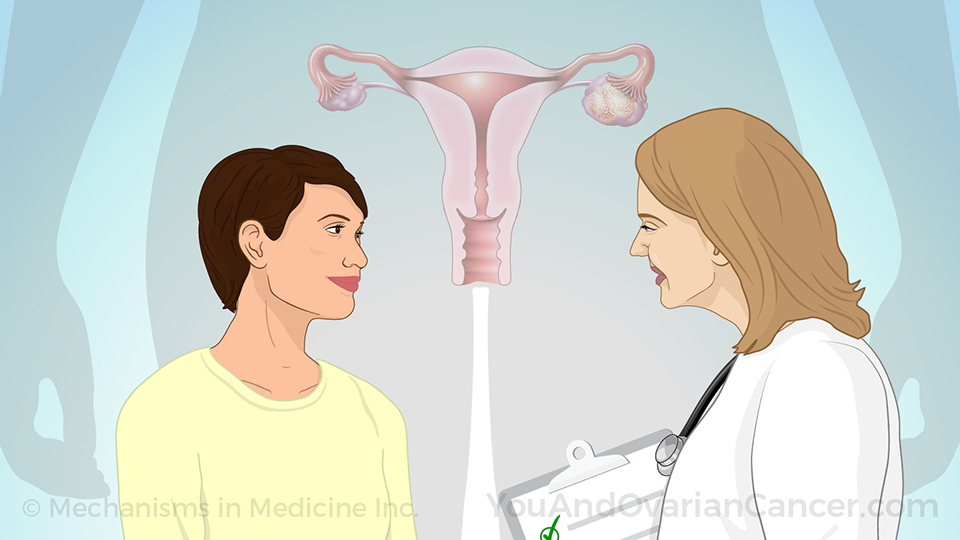














Slide Show - Understanding Ovarian Cancer
Your feedback is important to us! We will use your feedback to develop future areas of content about ovarian cancer which will help other patients, caregivers and families.






























Understanding Ovarian Cancer
*Please note: This slide show is not intended to be a substitute for professional medical advice, diagnosis, or treatment. Always consult your doctor about any questions you may have regarding a medical condition.
What is ovarian cancer?
The ovaries are part of a woman's reproductive system. From puberty until menopause, the ovaries store eggs and produce female hormones.
In general, the term "ovarian cancer" is often used to describe cancers that begin in the cells of the ovary, fallopian tube, or peritoneum.
What are the types of ovarian cancer?
The most common type of ovarian cancer is called epithelial ovarian cancer. It starts on the outer surface or in the lining of the ovaries.
Other types of ovarian cancer start in:
Ovarian cancer in the United States
Each year in the United States more than 21,000 women are diagnosed with ovarian cancer.
Who is at risk for ovarian cancer?
Ovarian cancer is most common after menopause. Older age remains a risk factor for most ovarian cancers.
All women are at risk, but some women are at higher risk if they:
What are the symptoms of ovarian cancer?
Symptoms of ovarian cancer may include:
What are the symptoms of ovarian cancer?
See your doctor if you have any of those symptoms for more than two weeks. Your doctor should perform a pelvic exam and may also order an ultrasound exam of the pelvis.
When ovarian cancer is in its early stages, you may not notice any symptoms. Also, other conditions can cause the same symptoms. For these reasons, ovarian cancer is often not diagnosed until after it has begun to spread.
Genetic changes and ovarian cancer
Some ovarian cancers are caused by genetic changes that can be inherited from either parent.
BRCA1 and BRCA2 are two genes that everyone has. When they change, or mutate, they can cause cancer.
Women who inherit a mutation in BRCA1 or BRCA2 have a higher risk for getting ovarian cancer and for being diagnosed at a younger-than-average age.
Inherited changes to BRCA1 or BRCA2 also increases risk for other cancers such as breast cancer.
Genetic changes and ovarian cancer
Changes in other genes that may run in families can also increase risk for ovarian cancer and other types of cancer.
Cancer experts recommend that all women with epithelial ovarian cancer be tested for changes in BRCA1, BRCA2, and other genetic changes.
A genetic counselor can help:
Can I reduce my risk for ovarian cancer?
You can take steps to reduce your risk for ovarian cancer:
Can I reduce my risk for ovarian cancer?
When you have completed childbearing, surgery to "tie" or remove your fallopian tubes can reduce your risk for ovarian cancer.
If you have genetic risk factors and carry a genetic mutation, you may be counseled to think about risk-reducing surgery to remove the ovaries or fallopian tubes.
If you have not yet gone through menopause, removing the ovaries will cause an immediate early menopause. Before considering this surgery, talk with your doctor about the side effects of early menopause and what you can expect.
What is ovarian cancer staging?
Ovarian cancer staging describes where the cancer is located in the body and the size of the cancer. This helps with choosing the best treatment.
Ovarian cancer has four main stages, ranging from Stage I (early disease) …
What is ovarian cancer staging?
… to Stage IV (advanced disease).
What’s the outlook for a patient with ovarian cancer?
Due to the nature of ovarian cancer, every patient may have a different experience. The outlook will depend on many factors, including the stage and type of ovarian cancer, your age and overall health.
In general, earlier detection means a better outlook.
Talk with your healthcare team about your own diagnosis to better understand your treatment options and what you can expect. If there's anything you don't understand, be sure to ask to have it better explained.
References
Your feedback is important to us! We will use your feedback to develop future areas of content about ovarian cancer which will help other patients, caregivers and families.















This educational activity has been developed by the National Ovarian Cancer Coalition in collaboration with Mechanisms in Medicine Inc.
This activity is supported by educational grants from:
Alkermes plc, AstraZeneca Pharmaceuticals LP, Clovis Oncology, Inc., Eisai Inc., Foundation Medicine, Inc., Genentech, a Member of the Roche Group, GSK, ImmunoGen, Inc., Merck & Co, Inc., Novartis, Novocure Inc., Pfizer, Inc.
Copyright © Mechanisms in Medicine Inc. All rights reserved. Mechanisms in Medicine Inc. does not provide medical advice, diagnosis, or treatment.
This website is part of the Animated Patient® series developed by Mechanisms in Medicine Inc., to provide highly visual formats of learning for patients to improve their understanding, make informed decisions, and partner with their healthcare professionals for optimal outcomes.